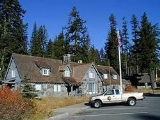
Munson Valley Historic District
Encyclopedia
Munson Valley Historic District is the headquarters and main support area for Crater Lake National Park
in southern Oregon
. The National Park Service
chose Munson Valley for the park headquarters because of its central location within the park. Because of the unique rustic architecture
of the Munson Valley buildings and the surrounding park landscape, the area was listed as a historic district
on the National Register of Historic Places
(NRHP) in 1988. The district has eighteen contributing buildings, including the Crater Lake Superintendent's Residence
which is a U.S. National Historic Landmark
and separately listed on the NRHP. The district's NRHP listing was decreased in area in 1997.
lies inside a caldera
created 7,700 years ago when the 12000 feet (3,657.6 m) high Mount Mazama
collapsed following a large volcanic eruption. Over the following millennium
, the caldera was filled with rain water forming today’s lake. The Klamath Indians revered Crater Lake for its deep blue waters. In 1853, three gold miners found the lake. They named it Deep Blue Lake, but because the lake was so high in the Cascade Mountains the discovery was soon forgotten.
In 1886, William Gladstone Steel
accompanied a United States Geological Survey
party led by Captain Clarence Dutton
to survey Crater Lake. The team carried a half-ton survey boat, the Cleetwood, up the steep mountain slope and lowered it 2000 feet (609.6 m) into the lake. During the visit, Steel named many of the lake's landmarks including Wizard Island
, Llao Rock, and Skell Head. The lake’s natural beauty made a great impression on Steel. As a result, when he returned from survey trip, he began advocating that Crater Lake be established as a national park
.
On 22 May 1902, President Theodore Roosevelt
signed the bill making Crater Lake the Nation's sixth national park. The United States Department of the Interior
was charged with developing road access and visitor services for the park. This was a difficult job because of the park’s remote location at the summit of the Cascade Mountains. By 1905, a "steep and tortuous" road to the crater rim had been completed. This access road was essential for the future development of the park.
In 1913, Congress appropriated funds for the Army Corps of Engineers to build a road around Crater Lake. The initial road survey identified the northern end of Munson Valley, three miles (5 km) south of the rim, as the best site for the road crew’s seasonal headquarters and supply depot. Not only was Munson Valley a central location, the surrounding valley provided timber for expanding the park facilities. However, United States
entry into World War I
slowed development of park infrastructure. The road around the lake was finally finished 1918. Once the road was completed, the National Park Service continued to use the Munson Valley site as a staging area for development projects throughout the park.
Between 1927 and 1930, a park warehouse, mess hall, bear-proof meat-house, comfort station with employee restrooms and showers, four small cottages, and two utility buildings were built. All these structures were designed in a common rustic style using timber from nearby stands and locally quarried stone.
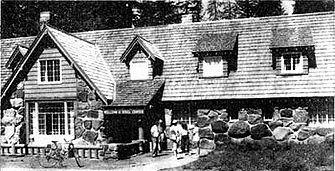 Between 1932 and 1936, houses for the park superintendent, park naturalist
Between 1932 and 1936, houses for the park superintendent, park naturalist
, and several other employees were completed along with four more utility buildings, a second comfort station, and a dormitory for park rangers. The old log headquarters building was demolished and a new rustic stone structure built in its place. The plaza in front of the new administration building had a landscaped island in the center with space to park 50 cars around the outside. During this period, Civilian Conservation Corps
crews planted over a thousand trees and several thousand shrubs in the Government Camp area. In addition, many small features such as flagstone walks, rustic signs, stone bridges, and drinking fountains were incorporated into the landscape. In 1938, Government Camp was re-named "Park Headquarters" by Superintendent Ernest P. Leavitt.
Development in Crater Lake National Park was curtailed during World War II
. Maintenance became the primary concern of the park staff, as Civilian Conservation Corps manpower disappeared with the onset of the war. This began a period of decline in park facilities.
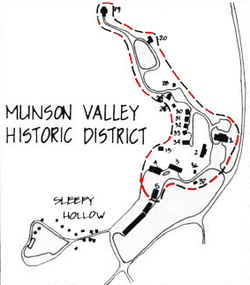 After World War II, the National Park Service began using the Munson Valley complex year-around. This had a tremendous impact on the historic landscape. Many landscape features including curbing, planting beds, and walkways had to be removed in order to widen narrow road to accommodate snow plows. Some porches had to be removed and snow tunnels were added to buildings for winter access. In 1954, all of the planters, lawns, and walks around the employee cottages were removed to facilitate snow removal. The traffic island near the upper group of cottages was also removed along with several utility buildings in the maintenance area to allow space for snow plows to turn around.
After World War II, the National Park Service began using the Munson Valley complex year-around. This had a tremendous impact on the historic landscape. Many landscape features including curbing, planting beds, and walkways had to be removed in order to widen narrow road to accommodate snow plows. Some porches had to be removed and snow tunnels were added to buildings for winter access. In 1954, all of the planters, lawns, and walks around the employee cottages were removed to facilitate snow removal. The traffic island near the upper group of cottages was also removed along with several utility buildings in the maintenance area to allow space for snow plows to turn around.
Over the years, there were other changes as well. The Fire Hall was demolished in 1969. In 1986, the ranger dormitory and the administration building were remodeled. A new snow tunnel was added to the west side of the administration building replacing the south entrance tunnel built in 1958. In 1990, several rustic utility buildings were torn down, and a gas station was removed in 1992. Despite the loss of landscape and original structures, the headquarters complex still reflects the original Munson Valley master plan and is a good example of the National Park Service rustic architecture. As a result, the area was listed as a historic district on the National Register of Historic Places in 1988 (NRHP #88002622). The historic area was at first 7.5 acres (3 ha) but was later reduced to 6 acres (2 ha).
Munson Valley Historic District extends south from the Superintendent's Residence and ends at the park warehouse at the north end of the maintenance area. The eighteen historic structures were built between 1926 and 1949. They include the, from north to south, the Superintendent's Residence, the park Naturalist's Residence, a cluster of staff residence cabins, the Administration Building, Ranger Dormitory, Transformer Building, Comfort Station, Mess Hall, Warehouse, and Machine Shop.

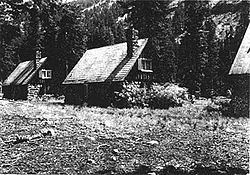
The historic district also includes various utility buildings including a mess hall, meat house, transformer building, comfort station (later converted to a sign shop), warehouse, and machine shop. These buildings all share common structural design elements that typify the park’s rustic style of architecture including massive stone masonry, rough-sawn board siding, stained timber beams, dormer windows, and steep pitched roofs.
At Munson Valley, rustic structures successfully blend with the natural environment. The buildings in the historic district are excellent examples of the rustic style of architecture, and represent one of the National Park Service's most successful development programs. In addition, the landscape surrounding the historic district remains virtually intact. As a result, the Munson Valley Historic District is significant as an expression of American naturalistic design.
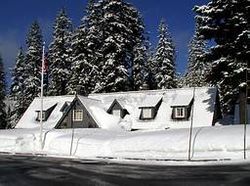 Munson Valley is located high in the Cascade Mountains, 6450 feet (1,966 m) above sea level. It is sixty miles (97 km) north of Klamath Falls, Oregon
Munson Valley is located high in the Cascade Mountains, 6450 feet (1,966 m) above sea level. It is sixty miles (97 km) north of Klamath Falls, Oregon
. The Munson Valley Historic District is three miles (5 km) south of Crater Lake and the Rim Village
visitor area which is also a historic district (NRHP #97001155). In the Crater Lake area, winter lasts eight months with an average snowfall of 533 inches (1,354 cm) per year, and many snow banks remain well into the summer. While most park roads are closed in the winter, the park headquarters, visitor center, and the other Munson Valley facilities are open year-around. However, winter storms make driving in the Crater Lake area unpredictable. During the summer, weather is generally warm, but nights are often quite cool. The National Park Service charges a $10 fee for private passenger vehicles entering the park. Commercial vehicles are charged between $25 and $200 depending on the vehicle's capacity.
Crater Lake National Park
Crater Lake National Park is a United States National Park located in southern Oregon. Established in 1902, Crater Lake National Park is the sixth oldest national park in the United States and the only one in the state of Oregon...
in southern Oregon
Oregon
Oregon is a state in the Pacific Northwest region of the United States. It is located on the Pacific coast, with Washington to the north, California to the south, Nevada on the southeast and Idaho to the east. The Columbia and Snake rivers delineate much of Oregon's northern and eastern...
. The National Park Service
National Park Service
The National Park Service is the U.S. federal agency that manages all national parks, many national monuments, and other conservation and historical properties with various title designations...
chose Munson Valley for the park headquarters because of its central location within the park. Because of the unique rustic architecture
National Park Service Rustic
National Park Service rustic, also colloquially known as Parkitecture, is a style of architecture that arose in the United States National Park System to create buildings that harmonized with their natural environment. Since its founding, the National Park Service consistently has sought to provide...
of the Munson Valley buildings and the surrounding park landscape, the area was listed as a historic district
Historic district
A historic district or heritage district is a section of a city which contains older buildings considered valuable for historical or architectural reasons. In some countries, historic districts receive legal protection from development....
on the National Register of Historic Places
National Register of Historic Places
The National Register of Historic Places is the United States government's official list of districts, sites, buildings, structures, and objects deemed worthy of preservation...
(NRHP) in 1988. The district has eighteen contributing buildings, including the Crater Lake Superintendent's Residence
Crater Lake Superintendent's Residence
Crater Lake Superintendent's Residence, is "an impressive structure of massive boulders and heavy-handed woodwork" at Crater Lake National Park in southern Oregon. It was declared a National Historic Landmark in 1987....
which is a U.S. National Historic Landmark
National Historic Landmark
A National Historic Landmark is a building, site, structure, object, or district, that is officially recognized by the United States government for its historical significance...
and separately listed on the NRHP. The district's NRHP listing was decreased in area in 1997.
Early history
Crater LakeCrater Lake
Crater Lake is a caldera lake located in the south-central region of the U.S. state of Oregon. It is the main feature of Crater Lake National Park and famous for its deep blue color and water clarity. The lake partly fills a nearly deep caldera that was formed around 7,700 years agoby the...
lies inside a caldera
Caldera
A caldera is a cauldron-like volcanic feature usually formed by the collapse of land following a volcanic eruption, such as the one at Yellowstone National Park in the US. They are sometimes confused with volcanic craters...
created 7,700 years ago when the 12000 feet (3,657.6 m) high Mount Mazama
Mount Mazama
Mount Mazama is a destroyed stratovolcano in the Oregon part of the Cascade Volcanic Arc and the Cascade Range. The volcano's collapsed caldera holds Crater Lake, and the entire mountain is located within Crater Lake National Park....
collapsed following a large volcanic eruption. Over the following millennium
Millennium
A millennium is a period of time equal to one thousand years —from the Latin phrase , thousand, and , year—often but not necessarily related numerically to a particular dating system....
, the caldera was filled with rain water forming today’s lake. The Klamath Indians revered Crater Lake for its deep blue waters. In 1853, three gold miners found the lake. They named it Deep Blue Lake, but because the lake was so high in the Cascade Mountains the discovery was soon forgotten.
In 1886, William Gladstone Steel
William Gladstone Steel
William Gladstone Steel , called the "father of Crater Lake", referring to the creation of Crater Lake National Park in Oregon, United States. A native of Ohio, he worked in the newspaper business before becoming a mail carrier...
accompanied a United States Geological Survey
United States Geological Survey
The United States Geological Survey is a scientific agency of the United States government. The scientists of the USGS study the landscape of the United States, its natural resources, and the natural hazards that threaten it. The organization has four major science disciplines, concerning biology,...
party led by Captain Clarence Dutton
Clarence Dutton
Clarence Edward Dutton was an American geologist and US Army officer. Dutton was born in Wallingford, Connecticut on May 15, 1841...
to survey Crater Lake. The team carried a half-ton survey boat, the Cleetwood, up the steep mountain slope and lowered it 2000 feet (609.6 m) into the lake. During the visit, Steel named many of the lake's landmarks including Wizard Island
Wizard Island
Wizard Island is a volcanic cinder cone which forms an island at the west end of Crater Lake in Crater Lake National Park, Oregon. The top of the island reaches above sea level, about above the average surface of the lake. The cone is capped by a volcanic crater about wide and deep. The...
, Llao Rock, and Skell Head. The lake’s natural beauty made a great impression on Steel. As a result, when he returned from survey trip, he began advocating that Crater Lake be established as a national park
National park
A national park is a reserve of natural, semi-natural, or developed land that a sovereign state declares or owns. Although individual nations designate their own national parks differently A national park is a reserve of natural, semi-natural, or developed land that a sovereign state declares or...
.
On 22 May 1902, President Theodore Roosevelt
Theodore Roosevelt
Theodore "Teddy" Roosevelt was the 26th President of the United States . He is noted for his exuberant personality, range of interests and achievements, and his leadership of the Progressive Movement, as well as his "cowboy" persona and robust masculinity...
signed the bill making Crater Lake the Nation's sixth national park. The United States Department of the Interior
United States Department of the Interior
The United States Department of the Interior is the United States federal executive department of the U.S. government responsible for the management and conservation of most federal land and natural resources, and the administration of programs relating to Native Americans, Alaska Natives, Native...
was charged with developing road access and visitor services for the park. This was a difficult job because of the park’s remote location at the summit of the Cascade Mountains. By 1905, a "steep and tortuous" road to the crater rim had been completed. This access road was essential for the future development of the park.
In 1913, Congress appropriated funds for the Army Corps of Engineers to build a road around Crater Lake. The initial road survey identified the northern end of Munson Valley, three miles (5 km) south of the rim, as the best site for the road crew’s seasonal headquarters and supply depot. Not only was Munson Valley a central location, the surrounding valley provided timber for expanding the park facilities. However, United States
United States
The United States of America is a federal constitutional republic comprising fifty states and a federal district...
entry into World War I
World War I
World War I , which was predominantly called the World War or the Great War from its occurrence until 1939, and the First World War or World War I thereafter, was a major war centred in Europe that began on 28 July 1914 and lasted until 11 November 1918...
slowed development of park infrastructure. The road around the lake was finally finished 1918. Once the road was completed, the National Park Service continued to use the Munson Valley site as a staging area for development projects throughout the park.
Government Camp
By 1924, the Munson Valley facilities were known as "Government Camp" and the site had become the park’s summer headquarters. Though the site had adequate space, the facilities were poorly designed and cheaply constructed. In 1925, National Park Service approved a master plan for developing Munson Valley. The development program began in 1927, and was overseen by the National Park Service’s Landscape Engineering Division, headed by Thomas C. Vint. The major components of the plan included construction of new administrative buildings, a new maintenance area, living quarters for park staff and seasonal employees, and general support buildings.Between 1927 and 1930, a park warehouse, mess hall, bear-proof meat-house, comfort station with employee restrooms and showers, four small cottages, and two utility buildings were built. All these structures were designed in a common rustic style using timber from nearby stands and locally quarried stone.

Naturalist
Naturalist may refer to:* Practitioner of natural history* Conservationist* Advocate of naturalism * Naturalist , autobiography-See also:* The American Naturalist, periodical* Naturalism...
, and several other employees were completed along with four more utility buildings, a second comfort station, and a dormitory for park rangers. The old log headquarters building was demolished and a new rustic stone structure built in its place. The plaza in front of the new administration building had a landscaped island in the center with space to park 50 cars around the outside. During this period, Civilian Conservation Corps
Civilian Conservation Corps
The Civilian Conservation Corps was a public work relief program that operated from 1933 to 1942 in the United States for unemployed, unmarried men from relief families, ages 18–25. A part of the New Deal of President Franklin D...
crews planted over a thousand trees and several thousand shrubs in the Government Camp area. In addition, many small features such as flagstone walks, rustic signs, stone bridges, and drinking fountains were incorporated into the landscape. In 1938, Government Camp was re-named "Park Headquarters" by Superintendent Ernest P. Leavitt.
Development in Crater Lake National Park was curtailed during World War II
World War II
World War II, or the Second World War , was a global conflict lasting from 1939 to 1945, involving most of the world's nations—including all of the great powers—eventually forming two opposing military alliances: the Allies and the Axis...
. Maintenance became the primary concern of the park staff, as Civilian Conservation Corps manpower disappeared with the onset of the war. This began a period of decline in park facilities.
Park Headquarters

Over the years, there were other changes as well. The Fire Hall was demolished in 1969. In 1986, the ranger dormitory and the administration building were remodeled. A new snow tunnel was added to the west side of the administration building replacing the south entrance tunnel built in 1958. In 1990, several rustic utility buildings were torn down, and a gas station was removed in 1992. Despite the loss of landscape and original structures, the headquarters complex still reflects the original Munson Valley master plan and is a good example of the National Park Service rustic architecture. As a result, the area was listed as a historic district on the National Register of Historic Places in 1988 (NRHP #88002622). The historic area was at first 7.5 acres (3 ha) but was later reduced to 6 acres (2 ha).
Structures
There are eighteen primary structures in the Munson Valley Historic District. While most of the buildings have been remodeled, they still reflect the rustic style of architecture which is the common design theme that makes the Munson Valley headquarters complex historically unique.Munson Valley Historic District extends south from the Superintendent's Residence and ends at the park warehouse at the north end of the maintenance area. The eighteen historic structures were built between 1926 and 1949. They include the, from north to south, the Superintendent's Residence, the park Naturalist's Residence, a cluster of staff residence cabins, the Administration Building, Ranger Dormitory, Transformer Building, Comfort Station, Mess Hall, Warehouse, and Machine Shop.

- The park Superintendent's ResidenceCrater Lake Superintendent's ResidenceCrater Lake Superintendent's Residence, is "an impressive structure of massive boulders and heavy-handed woodwork" at Crater Lake National Park in southern Oregon. It was declared a National Historic Landmark in 1987....
is located at north end of headquarters area. It was constructed in 1933. The building’s footprint is 33 by 61 feet (10 m × 18.6 m) with a rustic stone superstructure and wood-shake roof. The first floor includes an entry hall, living room with lava-rock fireplace, a dining room, kitchen, and bedroom with adjoining bathroom. The second floor has four additional bedrooms and two bathrooms. The building was framed in Douglas fir and the roof covered with cedar shakes. The Crater Lake Superintendent's ResidenceCrater Lake Superintendent's ResidenceCrater Lake Superintendent's Residence, is "an impressive structure of massive boulders and heavy-handed woodwork" at Crater Lake National Park in southern Oregon. It was declared a National Historic Landmark in 1987....
is a U.S. National Historic LandmarkNational Historic LandmarkA National Historic Landmark is a building, site, structure, object, or district, that is officially recognized by the United States government for its historical significance...
and is individually listed on the National Register of Historic Places (NRHP #87001347). Today, the building houses part of the park’s Science and Learning Center. - The park Naturalist's Residence is located between the Superintendent's Residence and the other employee houses near the north end of the historic district. The building’s footprint is the same as the Superintendent's Residence; however, the floor plan is slightly different. This first floor contained a living room with stone fireplace, a kitchen, breakfast room, bedroom, and bathroom. There are three additional bedrooms and a bath room upstairs. Today, the building houses part of the park’s Science and Learning Center.

- The historic district also includes six rustic stone Employee Cottages built for park staff between 1927 and 1931. These housing units are designated as buildings #24, 25, 28, 30, 31, and 32. They are architecturally significant because they were part of the original Munson Valley headquarters master plan, and were constructed in the rustic style using native stone and timber. While aluminum roofs were added in the mid-1950s, these units still retain their original character.
- The park Administration Building was built with a rough stone first story with rustic superstructure. It is 100 feet (30.5 m) long and 40 feet (12.2 m) wide. The main entrance led into a public lobby with a large fireplace and wood-paneled walls. Offices for the superintendent, assistant superintendent, comptroller, and information department were also on the first floor along with a large 42 by 15 feet (12.8 m × 4.6 m) room for the park’s clerical staff. The second floor has six additional offices and two storage rooms.
- The Ranger Dormitory was begun in 1932, but was not finished until 1936 due to lack of funds. It is constructed of native stone and timber. Originally, the first floor had an entry hall, men’s and women’s bathrooms, and two living rooms, each with its own stone fireplace. The larger living room, located in the north end of the building, was for men. A smaller living room plus three other rooms and a shower at the south end of the building were for women. The second floor had four bedrooms, a large 18 by 34 foot (5.5 m × 10.4 m) dormitory room, a dark room, storage room, and men’s shower. There is also a basement under the central portion of the building. Today, the National Park Service uses the building as its main visitor center. The William G. Steel Information Center is open to the public year-round. Visitor to the park can obtain general information, park maps, and backcountry permits at the center. The center has exhibits and an audio-visual program. First aid care is also available at the center.
The historic district also includes various utility buildings including a mess hall, meat house, transformer building, comfort station (later converted to a sign shop), warehouse, and machine shop. These buildings all share common structural design elements that typify the park’s rustic style of architecture including massive stone masonry, rough-sawn board siding, stained timber beams, dormer windows, and steep pitched roofs.
At Munson Valley, rustic structures successfully blend with the natural environment. The buildings in the historic district are excellent examples of the rustic style of architecture, and represent one of the National Park Service's most successful development programs. In addition, the landscape surrounding the historic district remains virtually intact. As a result, the Munson Valley Historic District is significant as an expression of American naturalistic design.
Access

Klamath Falls, Oregon
Klamath Falls is a city in Klamath County, Oregon, United States. Originally called Linkville when George Nurse founded the town in 1867, after the Link River on whose falls this city sat, although no falls currently exist; the name was changed to Klamath Falls in 1892...
. The Munson Valley Historic District is three miles (5 km) south of Crater Lake and the Rim Village
Rim Village Historic District
Rim Village is the main area for tourist services in Crater Lake National Park in southern Oregon, United States. It is located on the southwest rim of the caldera overlooking Crater Lake. The National Park Service designed Rim Village to concentrate park services at a location that provided easy...
visitor area which is also a historic district (NRHP #97001155). In the Crater Lake area, winter lasts eight months with an average snowfall of 533 inches (1,354 cm) per year, and many snow banks remain well into the summer. While most park roads are closed in the winter, the park headquarters, visitor center, and the other Munson Valley facilities are open year-around. However, winter storms make driving in the Crater Lake area unpredictable. During the summer, weather is generally warm, but nights are often quite cool. The National Park Service charges a $10 fee for private passenger vehicles entering the park. Commercial vehicles are charged between $25 and $200 depending on the vehicle's capacity.

